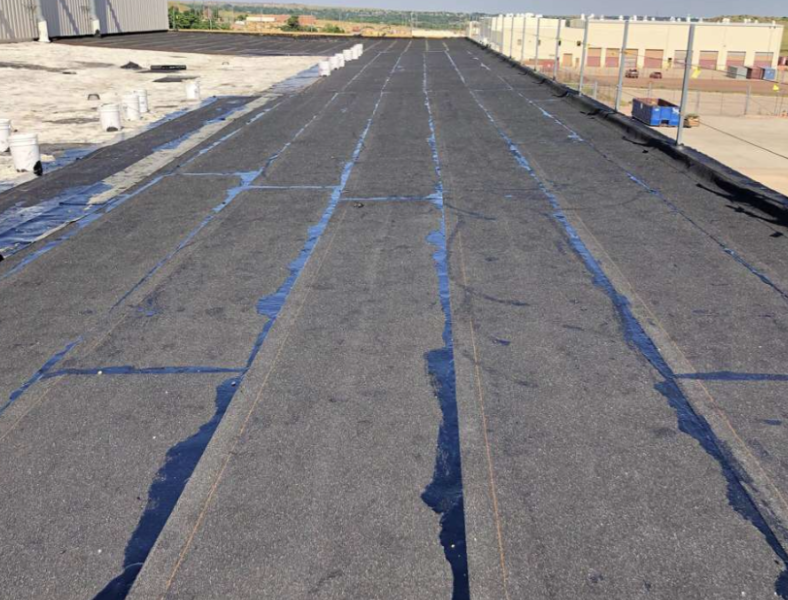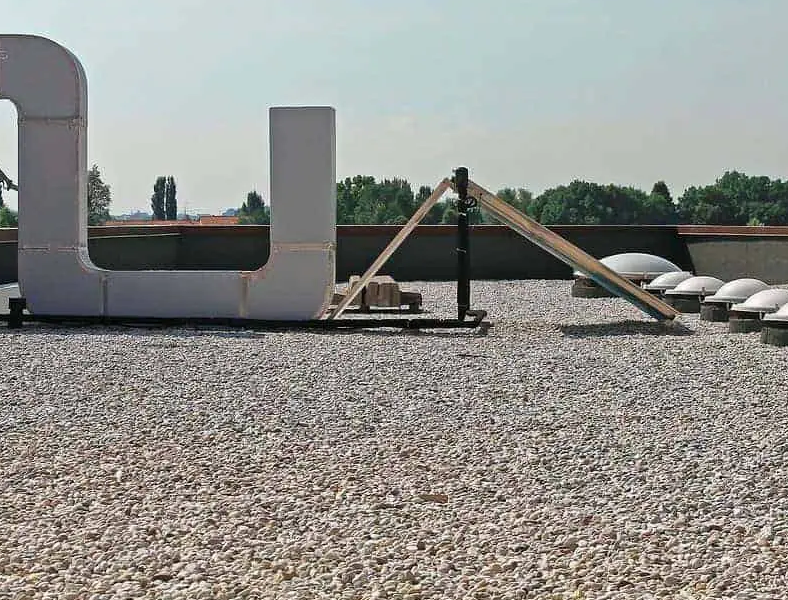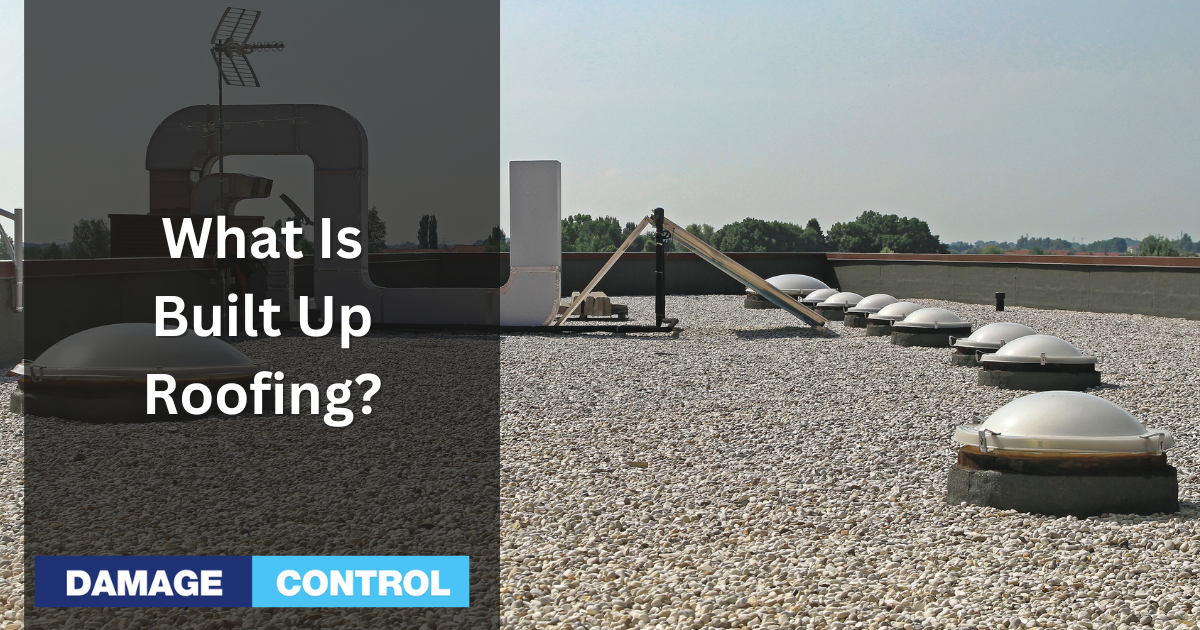Welcome, friends! Let's dive into the world of built-up roofing. In this beginner's guide, we'll unravel the mysteries behind this age-old roofing system.
Definition and history
Built-up roofing, or BUR, is a tried-and-true method that has been around for over a century. It consists of multiple layers of materials, creating a durable, watertight seal for your roof. This technique has withstood the test of time, evolving from its humble beginnings to a popular choice in today's roofing industry.
Key components
At the heart of BUR lies a sandwich-like structure. It starts with a solid base, usually made of plywood or another sturdy material. Next comes alternating layers of bitumen (asphalt or coal tar) and reinforcing fabrics, such as fiberglass or organic felts. Finally, a top layer of gravel or mineral granules is applied, protecting the roof from harsh weather and UV rays.
Common applications and benefits
Built-up roofing is a versatile option, perfect for both commercial and residential buildings. Its main advantages lie in its durability, low maintenance, and cost-effectiveness. With proper installation and care, a BUR system can last decades, ensuring your property stays safe and sound through all kinds of weather.
Materials Used in Built-Up Roofing

Let's explore the materials that make built-up roofing such a reliable choice. From bitumen to surfacing options, we'll cover everything you need to know.
Bitumen
Bitumen is the glue that holds built-up roofing together. There are two types to choose from:
Asphalt
Asphalt is the most commonly used bitumen in BUR systems. It's derived from crude oil, making it a flexible and waterproof adhesive. Asphalt has a natural resistance to temperature fluctuations and can be easily repaired if needed.
Coal tar
Coal tar is a byproduct of coal processing and is thicker and more resistant to water than asphalt. It's favored for its longevity and ability to withstand harsh chemicals. However, it's less common than asphalt due to environmental concerns and installation challenges.
Roofing felts
Roofing felts are essential for reinforcing the bitumen layers. There are two main types:
Organic felts
Organic felts are made from cellulose fibers, typically sourced from wood or paper. They're a budget-friendly option, but they tend to be less durable than their glass fiber counterparts.
Glass fiber felts
These felts are composed of woven glass fibers, providing superior strength and resistance to moisture. Glass fiber felts are lightweight and less prone to damage, making them a popular choice for BUR systems.
Insulation and cover boards
Insulation is crucial for energy efficiency and thermal performance, while cover boards protect the insulation and offer a smooth surface for BUR application. Materials like polyisocyanurate, expanded polystyrene, and extruded polystyrene are popular insulation choices. Cover boards typically consist of gypsum, cementitious wood fiber, or perlite.
Surfacing options

There's no shortage of surfacing options to protect and beautify your built-up roof:
Gravel
Gravel is a tried-and-true surfacing material, offering excellent durability and UV protection. It's relatively heavy, so it's important to ensure your roof can support the extra weight.
Mineral surfacing
Mineral surfacing consists of pre-coated granules embedded in the top layer of bitumen. It's a lightweight alternative to gravel, providing similar UV protection and aesthetic appeal.
Liquid-applied coatings
These coatings, usually made from acrylic, silicone, or urethane, are applied as a liquid and harden to form a waterproof, UV-resistant layer. They can prolong your roof's lifespan and help reduce energy costs.
Roofing granules
Roofing granules are small, ceramic-coated particles that provide UV protection and a splash of color. They're sprinkled onto the top layer of bitumen, giving your roof a clean, finished look.
So, there you have it! A comprehensive look at the various materials that make built-up roofing a reliable, long-lasting option for your property.
Now that we've covered the materials, let's explore the different types of built-up roofing systems. Each comes with its own set of advantages and installation methods, so let's break it down.
Hot-mopped built-up roofing
Hot-mopped BUR is the traditional approach to built-up roofing. It involves heating bitumen to a liquid state and then “mopping” it onto the roof surface. Layers of roofing felts are then added, with more hot bitumen applied between each layer. Hot-mopped BUR is known for its durability, but it does require an experienced crew and can be labor-intensive.
Cold-applied built-up roofing
If the idea of hot bitumen sounds intimidating, cold-applied BUR might be more your style. This system uses a cold adhesive, typically made of asphalt or a modified bitumen blend, that doesn't require heat for application. The process is similar to hot-mopped BUR, but it's less hazardous and more environmentally friendly. However, cold-applied systems may take longer to cure and require more maintenance.
Torch-applied built-up roofing
Torch-applied BUR, also known as torch-on roofing, utilizes a propane torch to heat the bitumen as it's applied to the roof surface. This method is faster than hot-mopping, as it eliminates the need for a separate heat source. Torch-applied systems provide excellent waterproofing and can be ideal for roofs with irregular shapes. But keep in mind that this method does carry a higher risk of fire and requires skilled, safety-conscious installers.
Self-adhering built-up roofing
As the name suggests, self-adhering BUR systems come with a pre-applied adhesive backing. They're easy to install, requiring only the removal of a protective film before being rolled onto the roof surface. This type of BUR is popular for its simplicity and lack of open flames or hot materials. However, it's essential to ensure proper alignment and adhesion during installation to avoid future issues.
With these four types of built-up roofing systems, you're sure to find the perfect fit for your project. Each offers unique benefits, so consider factors like budget, climate, and installation expertise when making your decision.
The Built-Up Roofing Installation Process
Now that we've covered the basics, let's walk through the built-up roofing installation process step by step. Getting familiar with these stages will help you better understand what to expect.
Surface preparation
A successful BUR installation starts with a clean, dry, and structurally sound surface. This involves removing any debris, old roofing materials, or contaminants. In some cases, repairs may be needed to ensure the roof is in good condition before proceeding.
Insulation and cover board installation
Next, insulation is laid down to improve energy efficiency and thermal performance. Cover boards follow, providing a smooth surface and additional protection for the insulation. Proper installation of these components is key to ensuring your BUR system's longevity and performance.
Bitumen application
With the surface prepped, it's time to apply the bitumen. The application method varies depending on the type of BUR system you've chosen (hot-mopped, cold-applied, torch-applied, or self-adhering). Regardless of the method, it's crucial to ensure an even, consistent layer of bitumen for maximum adhesion and waterproofing.
Roofing felt application
Now comes the alternating layers of bitumen and roofing felts. Each layer of felt is carefully rolled onto the bitumen, ensuring proper alignment and adhesion. This process is repeated until the desired number of layers is achieved, typically three to five. Remember, these layers are crucial for reinforcing your BUR system, so it's essential to get this step right.
Surfacing installation
Finally, the finishing touch: surfacing. The type of surfacing you choose (gravel, mineral surfacing, liquid-applied coatings, or roofing granules) will depend on your preferences and the specific needs of your project. Regardless of your choice, a proper surfacing installation will protect your roof from UV damage, weather, and general wear and tear.
Pros and Cons of Built-Up Roofing
As with any roofing system, built-up roofing has its pros and cons. Let's weigh the advantages and disadvantages to help you decide if BUR is the right choice for your project.
Advantages
Durability
Built-up roofing systems are known for their impressive durability. With proper installation and maintenance, a BUR can last decades, providing long-lasting protection for your property.
Weather resistance
BUR systems are designed to withstand all sorts of weather, from harsh sun to heavy rain and snow. Their multiple layers create a robust barrier against the elements, keeping your building safe and dry.
Low maintenance
Once installed, built-up roofing systems require minimal maintenance. Occasional inspections and prompt repairs of any damage will ensure your BUR stays in tip-top shape.
Energy efficiency
Thanks to the insulation and reflective surfacing options, BUR systems can help reduce energy costs. This means lower heating and cooling bills and a more comfortable indoor environment.
Disadvantages
Installation challenges
BUR installation can be labor-intensive, especially for hot-mopped and torch-applied systems. This means you'll need a skilled crew and may face higher installation costs.
Weight and structural considerations
Some BUR systems, particularly those with gravel surfacing, can be quite heavy. It's crucial to ensure your building can support the additional weight to avoid structural issues.
Odor and fumes
During installation, hot bitumen can produce strong odors and fumes. This can be a concern for occupants and neighbors, so proper ventilation and communication are essential.
Comparing Built-Up Roofing to Other Commercial Roofing Options
To make an informed decision, it's important to compare built-up roofing to other popular commercial roofing options. Let's take a look at how BUR stacks up against single-ply membranes, modified bitumen, and metal roofing.
Single-ply membranes
Single-ply membranes are a lightweight alternative to BUR, with three main types to consider:
TPO
Thermoplastic olefin (TPO) is known for its energy efficiency and UV resistance. It's often chosen for its reflective white surface and ease of installation. However, TPO may not be as durable as BUR or some other options.
EPDM
Ethylene propylene diene monomer (EPDM) is a rubber-based membrane that offers excellent flexibility and resistance to weathering. It's a budget-friendly option, but its black color can absorb heat, making it less energy-efficient than BUR or TPO.
PVC
Polyvinyl chloride (PVC) is a durable and fire-resistant roofing option, popular for its resistance to chemicals and ability to withstand ponding water. However, it can be more expensive than BUR or other single-ply options.
Modified bitumen
Modified bitumen is a close cousin to built-up roofing, featuring layers of bitumen reinforced with synthetic materials like polyester or fiberglass. It offers improved flexibility, weather resistance, and durability compared to BUR, but it can be more challenging to install.
Metal roofing
Metal roofing is a versatile and long-lasting option, available in various materials like steel, aluminum, and copper. It's lightweight, recyclable, and energy-efficient, but it can be more expensive to install and maintain compared to BUR.
Built-up roofing offers several advantages, like durability, weather resistance, and energy efficiency. Metal roofing, modified bitumen, and single-ply membranes are all commercial roofing options. Each option comes with its own set of benefits and drawbacks, so weigh your priorities and consult with a trusted roofing professional before making a decision.
Maintaining and Repairing a Built-Up Roof
Proper maintenance is key to prolonging the life of your built-up roof. Let's dive into the essentials of inspections, preventative measures, and repair techniques.
Regular inspections
Inspect your roof regularly. Aim for at least twice a year. Check for signs of wear, damage, or leaks. Don't forget to examine flashings, drains, and expansion joints. Catching issues early can save you time and money.
Preventative maintenance
Stay proactive. Clear debris, like leaves and branches, to prevent water buildup. Clean gutters and drains to ensure proper water flow. Trim overhanging tree limbs to minimize damage from falling debris. Preventative care goes a long way.
Repair techniques
If you spot damage, act fast. Here are some common repair techniques:
Patching
Small punctures or tears can be patched. Cut a piece of compatible roofing material slightly larger than the damaged area. Apply bitumen to the underside, and press it firmly onto the roof. Seal the edges with more bitumen.
Re-coating
Bitumen can wear down over time. Re-coating the roof with a compatible liquid-applied coating can restore its waterproofing and UV resistance. Make sure the roof is clean and dry before applying a new coat.
Re-surfacing
If your surfacing is damaged or worn, consider re-surfacing. Remove loose or damaged surfacing, clean the area, and apply a new layer. This will protect the underlying layers and prolong your roof's life.
Life Expectancy and Warranty Considerations
Understanding life expectancy and warranty considerations is crucial when investing in a built-up roof. Let's discuss factors affecting lifespan, typical warranties, and how to extend your roof's life.
Factors affecting lifespan
Several factors impact a built-up roof's longevity. Proper installation, regular maintenance, and local climate play significant roles. Material quality and roof design are also important. With the right care, a BUR can last 20 to 30 years or more.
Typical warranties and coverage
Warranties vary by manufacturer and installer. They usually cover material defects and workmanship errors. Coverage periods range from 10 to 30 years. Be sure to read the fine print. Understand the terms and conditions, and follow maintenance requirements to keep the warranty valid.
Extending the life of a built-up roof
Maximize your built-up roof's lifespan with these tips:
- Ensure proper installation by hiring experienced professionals.
- Conduct regular inspections to identify issues early.
- Perform routine maintenance to prevent problems from escalating.
- Address repairs promptly to avoid further damage.
- Follow manufacturer recommendations for care and upkeep.
By taking these steps, you'll help your built-up roof stand the test of time, providing reliable protection for years to come. Remember, a well-maintained roof is a long-lasting roof. So, invest in proper care and enjoy the benefits of your built-up roofing system.
Choosing the Right Built-Up Roofing Contractor
Selecting the right contractor for your built-up roofing project is crucial. Remember, you need a contractor with a proven track record in BUR roofing. Let's explore key factors to consider when making your choice.
Qualifications and experience
Look for a contractor with expertise in built-up roofing. They should have extensive experience installing, maintaining, and repairing BUR systems. Don't hesitate to ask about their background and the number of BUR projects they've completed.
Licensing and insurance
A reputable contractor should hold proper licensing and insurance. This protects you from potential liabilities. Verify their credentials, and make sure they have both general liability and workers' compensation insurance.
Client testimonials and references
Happy clients are a good sign. Check the contractor's online reviews and testimonials. Look for a pattern of satisfied customers. Request references from previous BUR projects and contact them for feedback on their experience.
Requesting and comparing quotes
Gather multiple quotes from different contractors. Compare the scope of work, materials, timeline, and pricing. Keep in mind that the lowest quote may not always be the best option. Consider their experience, reputation, and overall value when making your decision.
Frequently Asked Questions
Let's tackle some common questions about built-up roofing to give you a well-rounded understanding of this roofing option.
How much does a built-up roof cost?
The cost of a built-up roof depends on factors like materials, labor, and location. On average, expect to pay $4 to $8 per square foot. Keep in mind that additional features or complex installations may raise the price.
What is the best time of year to install a built-up roof?
Ideal installation conditions include dry weather and moderate temperatures. Late spring, summer, and early fall are typically the best times for built-up roofing projects.
Can a built-up roof be installed over an existing roof?
It's possible to install a BUR over an existing roof, depending on its condition and local building codes. Always consult with a professional to assess the situation and ensure proper adherence to regulations.
How long does it take to install a built-up roof?
The installation timeline varies based on factors like project size, weather, and contractor availability. Generally, a built-up roofing project can take anywhere from a few days to several weeks to complete.
Can I walk on my built-up roof?
Built-up roofs are designed to be durable, and limited foot traffic is usually acceptable. However, use caution and avoid walking on the roof during extreme temperatures or weather conditions.
How do I know if my built-up roof needs to be replaced?
Signs that your BUR may need replacement include extensive leaks, persistent moisture issues, visible deterioration, or reaching the end of its expected lifespan. Consult with a roofing professional to assess the condition and determine the best course of action.
These FAQs should help address some of your built-up roofing concerns. Remember, consulting with a trusted roofing professional is always the best way to ensure you're making informed decisions about your property's roofing needs.
Conclusion
In conclusion, built-up roofing is a time-tested and durable option for commercial and industrial buildings. A BUR system can provide reliable protection and energy efficiency for decades with proper installation and maintenance. Choosing the right contractor and staying informed about your roofing options are key to ensuring a successful project and a long-lasting roof.
As you consider your options, don't hesitate to explore other roofing materials and systems. For example, if you're interested in a more traditional look, a guide on clay tiles might be worth checking out. For something more unique, thatched roofs are an option you could consider. To better understand the various components of a roofing system, look at the varying quality of roof underlayments available.
Lastly, don't forget that proper care and maintenance are essential to preserving your roof's lifespan. Learn about the best chemicals to clean a roof and stay informed about proper upkeep methods. By investing in your roof and staying proactive about its care, you'll enjoy the benefits of a durable, long-lasting built-up roofing system. So, go ahead and explore our other articles to expand your roofing knowledge, and make the best choice for your property.

